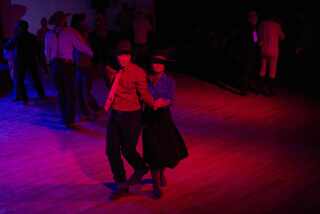Go Ahead, Have a Cow: It’s Udderly Cool : Animals: Whether it’s farming or friendship the small farmer wants, tiny Dexter cattle fit the bill.
- Share via
PUYALLUP, Wash. — Gary Prichard knows how to conserve natural resources. He sells compacts. Compact cows.
The Eugene, Ore., cattle breeder says tiny Dexter cows are a solution for those seeking self-sufficiency on limited acreage. The cows provide milk and meat, and they require far less pasture than full-size cattle.
Prichard, who is almost 6 feet tall, leans down to rub Dolly’s back. She stands about as high as his belt buckle. The animals generally range from 3 to not quite 4 feet tall, and they weigh about half of what the average Holstein does--which is about 1,000 pounds.
Dolly shares 60 acres of pasture with 35 or 40 other Dexters near the banks of the Coast Fork of the Willamette River. One acre of good pasture is enough for one Dexter. If pasture is unavailable, a Dexter can live on a daily ration of 15 to 25 pounds of quality hay.
Prichard’s Dexters look like midget black Angus cattle. They have silky coats, stocky bodies, short legs and small horns.
Dexters originated in Ireland more than a century ago, developed for smaller farms in the country. The Irish “house cow” met needs at home and abroad.
Manifests of old sailing vessels listed Dexters. The small bovines fit comfortably aboard the ships to provide milk and meat so crew and passengers could avoid rickets.
Some Dexters went ashore with colonists, and herds are now found in many countries. Some researchers believe Dexters were one of the first breeds to come to the New World, Prichard said.
The largest herds of Dexters now are found in England, the United States and Canada, reports of the American Dexter Cattle Assn. say. The hardy animals are at home in any climate--from Alaska, northern Canada and northern Europe to the heat extremes of Texas, Australia and South Africa.
Prichard bought his first Dexter in 1978 after reading an article about the breed’s useful qualities.
“That was the time of the ‘back to nature’ movement,” Prichard recalled. “When I read about how a Dexter cow could be cost-effective for a family, it made sense to me.”
The article created such a demand for Dexters that Prichard had a hard time finding one to buy. He eventually located a breeder in California and bought Tululah. He bought three more heifers in eastern Maryland and found more in Colorado, Utah and Ohio until he had enough to put together a herd.
Now Prichard and his brother, Alan, are breeding the cattle and selling breeding stock to “all kinds of people.”
“An 83-year-old gentleman in Chehalis, Wash., has one,” Prichard said. “He wanted his own milk cow and thought he could handle one this size.”
A woman in Onalaska, Wash., told Prichard her family always had cows, and she missed having one. She bought a Dexter to milk.
“Some people want to raise them for beef. Others just like to have them to keep their land grazed down so the brush doesn’t grow long,” Prichard said.
And some just like a visit from the loveable bovines.
“Sometimes I get a call from my neighbors across the river,” Prichard said. “They tell me, ‘Bernadette has come to visit.’ I offer to come over to get her, but they tell me to let her visit for a week or so and they’ll send her home.”
Once when the river was low enough for Bernadette to visit, she led the entire herd over to the Smiths. That time Prichard had to go over quickly to break up the party.
Prichard says Dexters are popular because their size makes them less threatening. The bulls are known for their pleasant disposition, but they are vocal.
“When I had two small bulls out in tall grass in the pasture, a neighbor said they reminded him of lions,” Prichard said. “He watched the grass part and heard the roar, but he couldn’t see the animals.”
Prichard exhibits his cattle at fairs and exhibitions, most recently at the Puyallup fair south of Seattle. He fields hundreds of questions about the animals and plans to start a newsletter soon to offer a voice to other Dexter breeders and those interested in learning more about the animals.
When raised as milk cows, they give about three gallons a day. Breeders also say the Dexter makes a good beef animal, yielding high-quality small joints of meat with good proportion of meat to bone. Average dress-out on beef animals is about 50% to 60%. The meat is tender and tasty, Prichard said, and is slightly darker red than commercial beef.
Bulls on an intensive feeding program can reach beef size by 12 months.
The companiable cattle do become a family of sorts at the Prichard ranch. Naming the animals provides additional interest.
One cow with a wart became Ibosan --or Mrs. Wart--when a Japanese exchange student helped with the naming process. Some of the names read like a royal roster--The Duke, Napoleon, P. Charles. One bull is named Winston, for Churchill. Houdini is a bull that can slip out of his halter in a minute.
Prichard likes to see the animals leave their riverside home to go to new families. He agrees with the philosophy that attracted him to Dexters in the first place--owning a Dexter makes good environmental sense.
As Prichard says: “The Irish house cow is now the perfect modern condo cow.”
More to Read
Sign up for Essential California
The most important California stories and recommendations in your inbox every morning.
You may occasionally receive promotional content from the Los Angeles Times.









